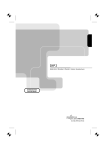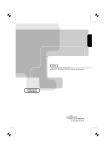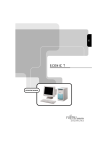Download Fujitsu Siemens Celsius 670 (LKN:SWD-670115
Transcript
WORKSTATION CELSIUS 670 BETRIEBSANLEITUNG OPERATING MANUAL Sie haben ... ... technische Fragen oder Probleme? Wenden Sie sich bitte an: • unsere Hotline: Mo-Fr: 9 - 18 Uhr Sa: 9 - 14 Uhr Tel.: +49 (0) 180 3777 003 • Ihren zuständigen Vertriebspartner • Ihre Verkaufsstelle Weitere Informationen finden Sie im Handbuch "Sicherheit, Garantie und Ergonomie". Aktuelle Informationen zu unseren Produkten, Tipps, Updates usw. finden Sie im Internet: http://www.fujitsu-siemens.com Are there ... ... any technical problems or other questions you need clarified? Please contact: • your sales partner • your sales outlet You will find further information in the "Safety, Warranty and Ergonomics" booklet. The latest information on our products, tips, updates, etc., can be found on the Internet under: http://www.fujitsu-siemens.com Dieses Handbuch wurde auf Recycling-Papier gedruckt. This manual has been printed on recycled paper. Ce manuel est imprimé sur du papier recyclé. Este manual ha sido impreso sobre papel reciclado. Questo manuale è stato stampato su carta da riciclaggio. Denna handbok är tryckt på recyclingpapper. Dit handboek werd op recycling-papier gedrukt. Herausgegeben von/Published by Fujitsu Siemens Computers GmbH Bestell-Nr./Order No.: A26361-K670-Z100-1-7419 Printed in the Federal Republic of Germany AG 0601 06/01 A26361-K670-Z100-1-7419 CELSIUS 670 BETRIEBSANLEITUNG OPERATING MANUAL Introduction Important notes CELSIUS 670 Preparation for Use and Operation Troubleshooting and tips Technical data Operating Manual Index June 2001 edition Microsoft, MS, MS-DOS, Windows, and Windows NT are registered trademarks of Microsoft Corporation. VESA and DPMS are trademarks of Video Electronics Standards Association. PS/2 is a registered trademark of International Business Machines, Inc. Pentium is a registered trademark of Intel Corporation, USA. Adobe and Acrobat are trademarks of Adobe Systems Incorporated and may be protected in certain countries. All other trademarks referenced are trademarks or registered trademarks of their respective owners, whose protected rights are acknowledged. Copyright ã Fujitsu Siemens Computers GmbH 2001 All rights, including rights of translation, reproduction by printing, copying or similar methods, in part or in whole, are reserved. Offenders will be liable for damages. All rights, including rights created by patent grant or registration of a utility model or design, are reserved. Delivery subject to availability. Right of technical modification reserved. This manual was produced by cognitas. Gesellschaft für Technik-Dokumentation mbH www.cognitas.de Contents Introduction .....................................................................................................................................1 Notational conventions ......................................................................................................................1 Important notes ...............................................................................................................................3 Safety ................................................................................................................................................3 Manufacturer’s notes .........................................................................................................................4 Energy saving............................................................................................................................4 Disposal and recycling...............................................................................................................4 CE certificate .............................................................................................................................4 FCC Class B Compliance Statement .........................................................................................5 Transporting the workstation .............................................................................................................6 Cleaning the workstation ...................................................................................................................6 Preparation for Use and Operation ................................................................................................7 Unpacking and checking the delivery ................................................................................................7 Steps for initial setup .........................................................................................................................7 Setting up the workstation .................................................................................................................8 Connecting devices ...........................................................................................................................8 Ports for external devices ..........................................................................................................9 Connecting the keyboard...........................................................................................................9 Connecting the mouse............................................................................................................. 10 Connecting devices with a serial or a parallel connection ........................................................ 10 Connecting the monitor to the electricity supply ....................................................................... 10 Connecting the workstation to the mains voltage ............................................................................. 11 Switching the workstation on and off ............................................................................................... 12 Switching on the workstation for the first time .......................................................................... 13 Switching the workstation on ................................................................................................... 14 Switching off the workstation ................................................................................................... 14 Indicators on the workstation ........................................................................................................... 15 Keyboard......................................................................................................................................... 16 Important keys and key combinations...................................................................................... 17 Working with floppy disks ................................................................................................................ 18 Settings in BIOS Setup .................................................................................................................... 19 Property and data protection ........................................................................................................... 19 Anti-theft protection ................................................................................................................. 19 Troubleshooting and tips.............................................................................................................. 21 Installing new software .................................................................................................................... 21 Power-on indicator remains unlit after you have switched on your device........................................ 21 The screen stays blank.................................................................................................................... 22 No mouse pointer displayed on the screen ...................................................................................... 23 The floppy disk cannot be read or written ........................................................................................ 23 Time and/or date is not correct ........................................................................................................ 23 Error messages on the screen......................................................................................................... 23 Restoring the hard disk contents ..................................................................................................... 23 Tips ............................................................................................................................................... 24 Technical data ............................................................................................................................... 25 Index............................................................................................................................................... 27 A26361-K670-Z100-1-7419 Deutsch Introduction Your CELSIUS Personal Workstation is a high-end workstation for the most demanding applications - from 3D-CAD applications to 3D-Studio applications, right up to numerical simulations and realtime animations of textured objects. This operating manual tells you how to put your workstation into operation and how to operate it in daily use. Your workstation is available in various configuration levels, which differ in hardware and software equipment. In addition, you can have installed accessible drives (e.g. DAT drive) and hard disks, as well as other boards. Depending on the workstation, the operating system, drivers and software utilities are pre-installed on the hard disk to facilitate the procedure when you use your workstation for the first time. Your workstation has a number of security features to ensure that no unauthorised persons can access your data. For example, you can activate a screen saver with password protection. The security functions in the BIOS Setup also allow you to protect your data by means of passwords. Additional information on this workstation is also contained in: • • • • • • • in the maintenance manual for the workstation in the "Safety, Warranty and Ergonomics" booklet in the manual "First Steps - Windows NT 4.0 Setup" in the operating manual for the monitor in the technical manual for the system board and for the BIOS Setup in the information files (e.g. *.TXT, *.DOC, *.WRI, *.HLP) in the manuals of the built-in boards (SCSI controller, graphics card, network adapter) i Some of the manuals listed can be found on the "Drivers & Utilities" CD provided with your computer. These manuals can be read and printed with the programme Acrobat Reader contained on the CD. Notational conventions The meanings of the symbols and fonts used in this manual are as follows: ! i Ê Pay particular attention to texts marked with this symbol. Failure to observe this warning endangers your life, destroys the workstation, or may lead to loss of data. Supplementary information, remarks, and tips follow this symbol. Text which follows this symbol describes activities that must be performed in the order shown. Text in this typeface indicates screen outputs. Text in italics indicates commands or menu items. "Quotation marks" indicate names of chapters or terms. A26361-K670-Z100-1-7419 English - 1 Important notes In this chapter you will find information regarding safety which it is essential to take note of when working with your workstation. The manufacturer's notes contain helpful information on your workstation. Safety ! ! Pay attention to the information provided in the "Safety, Warranty and Ergonomics" booklet and to the following notes. • • The activities described in the maintenance manual may only be performed by engineers or maintenance/technical staff. Only qualified technicians should repair the device. Disregarding these instructions can endanger the user (electric shock, risk of fire) and/or damage the device. For this reason, opening the unit without authorisation (engineers or maintenance/technical staff) voids the warranty and cancels any liability. • • • • During installation and before operating the device, please observe the instructions on environmental conditions in the chapter entitled "Technical data" as well as the instructions in the chapter "Preparation for Use and Operation". If the device is brought into the installation site from a cold environment, condensation - both inside and on the cover - can form. Before operating the device, wait until it is absolutely dry and has reached approximately the same temperature as the installation site. Failure to observe these guidelines can lead to material damage of the device. The device automatically sets itself to the correct rated voltage from 100 V to -240 V. Ensure that the local mains voltage lies within these limits. The power button does not separate the workstation completely from the mains voltage. To completely disconnect the mains voltage, remove the power plug from the grounded mains outlet. A26361-K670-Z100-1-7419 English - 3 Important notes Manufacturer’s notes Manufacturer’s notes Keep this operating manual together with your device. If you pass on the device to third parties, you should include this manual. Energy saving When the device is delivered, some energy-saving functions are already set (see the technical manual for the system board and for the "BIOS Setup"). • • Switch the workstation off when you are not using it. In the BIOS Setup you may set further energy-saving functions for the workstation (see the Technical Manual of the system board and for the "BIOS Setup"). Disposal and recycling This device has been manufactured to the highest possible degree from materials which can be recycled or disposed of in a manner that is not environmentally damaging. The device may be taken back after use to be recycled, provided that it is returned in a condition that is the result of normal use. Any components not reclaimed will be disposed of in an environmentally acceptable manner. Do not throw lithium batteries into the household waste. They must be disposed of in accordance with local regulations concerning special waste. If you have any questions about disposal of the batteries or system, please contact your local sales outlet or: Fujitsu Siemens Computers GmbH Recyclingcenter D-33106 Paderborn Tel.: +49 (0) 5251 81 80 10 Fax: +49 (0) 5251 81 80 15 CE certificate The shipped version of this device complies with the requirements of the EEC directives 89/336/EEC "Electromagnetic compatibility" and 73/23/EEC "Low voltage directive". 4 - English A26361-K670-Z100-1-7419 Manufacturer’s notes Important notes FCC Class B Compliance Statement The following statement applies to the products covered in this manual, unless otherwise specified herein. The statement for other products will appear in the accompanying documentation. NOTE: This equipment has been tested and found to comply with the limits for a "Class B" digital device, pursuant to Part 15 of the FCC rules and meets all requirements of the Canadian InterferenceCausing Equipment Regulations. These limits are designed to provide reasonable protection against harmful interference in a residential installation. This equipment generates, uses and can radiate radio frequency energy and, if not installed and used in strict accordance with the instructions, may cause harmful interference to radio communications. However, there is no guarantee that interference will not occur in a particular installation. If this equipment does cause harmful interference to radio or television reception, which can be determined by turning the equipment off and on, the user is encouraged to try to correct the interference by one or more of the following measures: • • • • Reorient or relocate the receiving antenna. Increase the separation between equipment and the receiver. Connect the equipment into an outlet on a circuit different from that to which the receiver is connected. Consult the dealer or an experienced radio/TV technician for help. Fujitsu Siemens Computers GmbH is not responsible for any radio or television interference caused by unauthorised modifications of this equipment or the substitution or attachment of connecting cables and equipment other than those specified by Fujitsu Siemens Computers GmbH. The correction of interference caused by such unauthorised modification, substitution or attachment will be the responsibility of the user. The use of shielded I/O cables is required when connecting this equipment to any and all optional peripheral or host devices. Failure to do so may violate FCC rules. A26361-K670-Z100-1-7419 English - 5 Important notes Transporting the workstation Transporting the workstation ! Transport all parts separately in their original packaging or in a packaging which protects them from knocks and jolts, to the new site. Do not unpack them until all transportation manoeuvres are completed. Never drop the monitor (risk of implosion)! Cleaning the workstation ! Turn off all power and equipment switches and pull the power plug out of the grounded mains outlets. The inside of the workstation housing may only be cleaned by authorised, specially trained personnel. Do not use any cleaning agents that contain abrasives or may corrode plastic. Ensure that no liquid enters the system. Ensure that the ventilation areas of the workstation and the monitor are free. Cleaning the workstation and the monitor Wipe the workstation and monitor casing with a dry cloth. If particularly dirty, use a cloth that has been moistened in mild domestic detergent and then carefully wrung out. Cleaning the keyboard and the mouse Use disinfectant wipes to clean the keyboard and the mouse. The mouse mechanism and the mouse ball can be cleaned by removing the retaining ring on the underside of the mouse. Ê Ê Ê Ê Ê Using two fingers push the retaining ring and turn the ring in the direction of the arrows. Remove the retaining ring and the rotating ball. Clean the ball and the three small wheels in the mouse with a lint-free cloth. Replace the ball and the retaining ring. Using two fingers, push the retaining ring and turn the ring in the opposite direction of the arrows. You should feel the ring engage. 6 - English A26361-K670-Z100-1-7419 Preparation for Use and Operation ! Please take note of the safety information in the "Important notes" chapter. Unpacking and checking the delivery It is recommended not to throw away the original packaging material! It may be required for reshipment at some later date. Ê Ê Ê Unpack all the individual parts. Check the delivery for damage incurred during transportation. Check whether the delivery agrees with the details in the delivery note. Should you discover that the delivery does not correspond to the delivery note, notify your local sales outlet immediately. ! If you have received drives or boards with your Workstation, please do not have them installed by engineers or maintenance/technical staff until after initial installation (see the maintenance manual). Steps for initial setup When starting up for the first time, the devices (monitor, mouse, keyboard etc.) are connected to the workstation and the software provided is set up. When you set up the workstation for the first time, you should carry out the following steps in the order shown. 1. Decide where you are going to install the workstation. 2. Connect the external devices to the workstation. 3. Connect the workstation and the monitor to the mains voltage. 4. Switch the workstation on and follow the instructions on the screen. A26361-K670-Z100-1-7419 English - 7 Preparation for Use and Operation Setting up the workstation Setting up the workstation ! When installing your workstation, give consideration to the recommendations and safety notes in the "Safety, Guarantee and Ergonomics" booklet. Set up the workstation only in its correct orientation. The points to observe are illustrated on the following pages. We recommend that you place your equipment on a surface with good anti-slip qualities. In view of the multitude of different finishes and varnishes used on furniture, it is possible that the rubber feet of the devices will mark the surface they stand on. Do not expose the workstation to extreme environmental conditions (see chapter "Technical data"). Protect it from dust, humidity and heat. Provide at least 200 mm of clearance in front of and behind the fan area of the workstation to ensure adequate ventilation. Do not cover the ventilation areas of the monitor and the workstation. Do not place several workstations one above the other. Connecting devices ! The power plug must be disconnected! Read the documentation on the external device before connecting it. Do not connect or disconnect cables during a thunderstorm. Always take hold of the actual plug. Never unplug a cable by pulling the cable itself. Connect and disconnect the cables in the order described below. Route the cables so that no dangerous points (tripping) result. Connecting cables • • • • • Turn off all power and equipment switches. Unplug all power plugs from the mains supply. Connect all cables at the workstation and peripherals. Under all circumstances, please observe the safety notes provided in the "Important notes" chapter. Plug all data communication cables into the utility sockets. Plug all power cables into the mains supply. Disconnecting cables • • • • Turn off all power and equipment switches. Unplug all power plugs from the mains supply. Unplug all data communication cables from the utility sockets. Disconnect all cables from the workstation and peripherals. 8 - English A26361-K670-Z100-1-7419 Connecting devices Preparation for Use and Operation Ports for external devices The ports for external devices are on the rear and on the front of the workstation. The ports available on your device depend on the configuration level you have selected. The standard ports are marked with the symbols shown below (or similar). Exact details of the position of the ports are supplied in the technical manuals for the boards. Keyboard port / purple 1 Serial interface 1 / turquoise PS/2 mouse port / green 2 Serial interface 2 / turquoise Monitor port / blue Parallel interface / Printer / burgundy USB port / black Game port / gold Microphone jack (mono) / pink SmartCard reader Audio output (Line out) / lime green Audio input (Line in) / light blue i LAN LAN connector SCSI connection Some of the devices that you connect require special drivers (see the operating system and device documentation). Connecting the keyboard Depending on the selected equipment level, your workstation will be supplied with a standard keyboard or a USB keyboard. Connecting standard keyboard Use the supplied keyboard cable only. Ê Plug the other end of the keyboard cable (square plug) into the socket on the underside of the keyboard. Ê Plug the round keyboard cable connector into the port marked with this symbol system unit. A26361-K670-Z100-1-7419 on the English - 9 Preparation for Use and Operation Connecting devices Connecting USB keyboard Use the supplied keyboard cable only. Ê Plug the other end of the keyboard cable (square plug) into the socket on the underside of the keyboard. Ê Insert the rectangular USB plug of the keyboard cable into the USB port unit. on the system Connecting the mouse Ê Plug the connector of the mouse cable into the mouse port. i If you do not attach a mouse at the PS/2 mouse port, you can disable the mouse controller in the BIOS Setup in order to free the IRQ12 for a different application. Connecting devices with a serial or a parallel connection Ê Ê Connect the data cable to the external device. Connect the data cable of the external device to the appropriate port on the workstation. i Most devices that you connect to the serial or parallel port require special drivers. Your operating system already includes many drivers. But if the driver you need is not on the hard disk please install it from the floppy disk or CD (supplied with the device or with the application programme). If you need to change the settings of the serial or parallel port (e.g. address, interrupt), you can do so in the BIOS Setup. The possible settings for the interfaces are described in the technical manual for the system board and for the "BIOS Setup". Connecting the monitor to the electricity supply Ê Ê Ê Follow the instructions contained in the monitor manual to prepare the monitor for operation. Plug the data cable of the monitor into the monitor port of the workstation. Plug the power cable of the monitor into the grounded mains outlet. 10 - English A26361-K670-Z100-1-7419 Connecting the workstation to the mains voltage Preparation for Use and Operation Connecting the workstation to the mains voltage 2 1 Ê Plug the workstation's power cable into the workstation (1) and then into the grounded mains outlet (2). A26361-K670-Z100-1-7419 English - 11 Preparation for Use and Operation Switching the workstation on and off Switching the workstation on and off 1 2 1 = Power button 2 = Power-on indicator Workstation is ready for operation The power-on indicator (2) flashes green. In this mode, you can switch the workstation on with the ON/OFF switch (1). The "ready-to-operate" status corresponds to the "stand-by" status of a TV set. A full description of the power-on indicator (2) can be found in the "Indicators on the workstation" section. Workstation is on The power-on indicator (2) lights green. The workstation can be switched ready-to-operate with the ON/OFF switch (1). 12 - English A26361-K670-Z100-1-7419 Switching the workstation on and off Preparation for Use and Operation Switching on the workstation for the first time When you switch on your workstation for the first time the supplied software is set up and configured. You should plan some time for this, as this process must not be interrupted. i If the workstation is integrated into a network, the user and server details as well as the network protocol are required. Contact your network administrator or network administrator if you have any questions about these details. For initial start-up of Windows NT, the manual "First Steps - Windows NT 4.0 Setup" provides an overview of the required information. If you have received data from your network or network administrator, then please enter this data in the spaces provided in the "First Steps" manual. This simplifies first-time installation. You may require the Windows licence number during installation. This number is located on a sticker on your workstation. Ê Ê Switch your monitor on. Switch the workstation on with the ON/OFF switch. The power-on indicator lights green and the workstation is started. Ê Ê Adjust the brightness if necessary (see the operating manual for the monitor). During installation, follow the instructions on screen. ! Once the installation has been started the workstation must not be switched off. You should only reboot the workstation during installation if you are requested to do so. Otherwise the installation will be not be performed correctly. If a fault occurs during the installation, the contents of the hard disk must be completely restored. Consult the operating system manual if there is anything unclear about the requested input data. Further information about the system, drivers, utilities, updates, manuals etc., is contained on the "Drivers & Utilities" CD. A26361-K670-Z100-1-7419 English - 13 Preparation for Use and Operation Switching the workstation on and off Switching the workstation on Ê Ê Switch the monitor on (see the operating manual for the monitor). Press the ON/OFF switch on the front of the workstation. The power-on indicator lights green, the workstation is started. i If you have assigned the system password, you must enter this when requested to do so in order to start the operating system. Switching off the workstation Ê Ê Shut down the operating system properly. Windows in the Start menu via the Quit function. If the operating system does not automatically switch the workstation off, turn the workstation off when requested to do so by pressing the ON/OFF switch. If the workstation is ready-to-operate, the power-on indicator flashes up green. The workstation uses a minimum of electricity. i The ON/OFF switch does not separate the workstation from the mains voltage. To completely disconnect the mains voltage, remove the power plug from the socket. 14 - English A26361-K670-Z100-1-7419 Indicators on the workstation Preparation for Use and Operation Indicators on the workstation 1= 2= 3= 4= 1 CD-ROM indicator Power-on indicator Hard disk indicator Floppy disk indicator 2 3 4 1 - CD-ROM indicator The indicator lights up when the CD-ROM drive of the workstation is accessed. You may only remove the CD when the indicator is dark. 2 - Power-on indicator − lights green: The workstation is on. − flashing green: The indicator only flashes on systems which support the ACPI function (Advanced Configuration and Power Management Interface). The workstation is in the energy-saving mode (standby). After being switched on with the ON/OFF switch, the workstation returns to the state it was in before the energy-saving mode. In the energy-saving mode the workstation may not be disconnected from the mains supply, as this may otherwise result in data loss. − does not glow: The workstation is switched off. 3 - Hard disk indicator The indicator lights up when the hard disk drive of the workstation is accessed. 4 - Floppy disk indicator The indicator lights up when the floppy disk drive of the workstation is accessed. You may only remove the floppy disk when the indicator is unlit. A26361-K670-Z100-1-7419 English - 15 Preparation for Use and Operation Keyboard Keyboard 1 3 1 = Function keys 2 = Power button (optional) 3 = Alphanumeric keypad i 2 4 5 4 = Cursor keys 5 = Numeric keypad (calculator keypad) The illustrated keyboard is an example and may differ from the model you use. 16 - English A26361-K670-Z100-1-7419 Keyboard Preparation for Use and Operation Important keys and key combinations The following description of keys and key combinations refers to MS Windows. Details of other keys and key combinations can be found in the documentation of the relevant application programme. ON/OFF switch Depending on the setting in the BIOS setup, the system can be switched on or off with this switch. With Windows 98 with ACPI or with Windows 2000 you can set additional functions of the power button in the Control Panel. On some keyboards the power button can only be used with ACPI. Otherwise the key is inoperative. Enter key confirms or starts the marked selection. The enter key is also referred to as the "Return" key. Start key calls up the Windows Start menu. Menu key invokes the menu for the marked item (Windows). Shift key enables upper-case letters and the upper key symbols to be used. Alt Gr Alt Gr (e.g. German keyboard) produces a character shown on the right-hand side of a key (e.g. the character "\" on the key [ß]). [ß] E Euro key outputs the Euro symbol when pressed simultaneously with the [Alt Gr] key. Num Lock Ctrl Ctrl Num Lock key by pressing the Num Lock key you switch between the Numeric keypad cursor control functions and digit or comma functions. When the Num Lock indicator is lit the digit and comma keys are active. When the Num Lock indicator is not lit the cursor control functions are active in the Numeric keypad. Ctrl key starts key combination actions. Alt A26361-K670-Z100-1-7419 Del Warm boot restarts the workstation. First hold down the [Ctrl] and [Alt] keys, and then press the [Del] key. With Windows 98, Windows 2000, Windows ME and Windows NT Task Manager appears first. Then you must press all three keys again to re-boot. English - 17 Preparation for Use and Operation Working with floppy disks Working with floppy disks ! Follow the instructions supplied by the vendor of the floppy disks. Never clean the floppy disk drives with cleaning disks. Any attempt would destroy the read/write head in the disk drive within 20 seconds. 5 4 6 7 1 2 3 1= 2= 3= 4= 5= 6= 7= Insertion direction Label area Write protection switch for a 720 KB or a 1.44 MB floppy disk Identification of a 1.44 MB floppy disk or write protect switch on a 120 MB floppy disk Eject button for inserted floppy disks Disk is write-protected Disk is not write-protected Ê To insert a floppy disk, push it into the drive in the insertion direction until it engages. The label should be facing upward. Ê To remove the floppy disk, press the eject button (5). The write-protect switch enables you to protect the data on the floppy disk from inadvertent overwriting or deletion. Ê To protect the data on the floppy disk from being overwritten, push the write-protect switch to position (6). The hole is now visible. To remove write protection, push the switch to position (7). The hole is now covered. 18 - English A26361-K670-Z100-1-7419 Settings in BIOS Setup Preparation for Use and Operation Settings in BIOS Setup The BIOS Setup menu allows you to set your hardware configuration and system functions of the workstation. When the device is delivered, the default entries are valid (see technical manual for the system board and for the "BIOS Setup"). You may customise these settings to your requirements in the BIOS Setup. The technical manual of the system board and for the "BIOS Setup" shows you how to start and use the BIOS Setup. The menus and setting options provided by the BIOS Setup are also described in detail. Property and data protection The software functions and mechanical lock on your workstation enable you to protect your system and personal data against unauthorised access. By combining these options, you can achieve maximum protection for your system. Anti-theft protection There are the following ways to protect your workstation from theft: • with a chain and the eyelet (a) a = Eyelet on casing a A26361-K670-Z100-1-7419 English - 19 Troubleshooting and tips ! Take careful note of the safety warnings in the "Safety, Warranty and Ergonomics" booklet and in the "Preparation for Use and Operation" chapter, when you connect or disconnect cables. If a fault occurs, try to correct it as described in the following places: • • • • in this chapter in the documentation of the connected devices in the help systems of the software used in the documentation of your operating system If you fail to correct the problem, proceed as follows: Ê Ê Switch off the workstation. Ê Contact your sales outlet or our customer service centre. Make a note of the steps and the circumstances that led to the fault. Also make a note of any error messages displayed and the Ident-No. of your device. Installing new software When installing programmes or drivers, important files may be overwritten and modified. To be able to access the original data in the case of any problems following installation, you should backup your hard disk prior to installation. Power-on indicator remains unlit after you have switched on your device This may be due to the following: The mains voltage supply is faulty Ê Check that the power cable is plugged properly into the workstation and grounded mains outlet. Internal power supply overloaded Ê Ê Ê Disconnect the power plug of the workstation from the grounded mains outlet. Wait for a moment. Plug the power plug into the grounded mains outlet again. A26361-K670-Z100-1-7419 English - 21 Troubleshooting and tips The screen stays blank If your screen remains blank this may be due to the following: Monitor is switched off Ê Switch your monitor on. Power saving has been activated (screen is blank) Ê Press any key on the keyboard. or Ê Deactivate the screen saver. Enter the appropriate password. Brightness control is set too dark Ê Adjust the brightness control. For detailed information, please refer to the operating manual supplied with your monitor. Power cable or monitor cable not connected Ê Ê Ê Switch off the monitor and the workstation. Ê Switch on the monitor and the workstation. Check whether the power cable is properly connected to the monitor and to the mains outlet. Check that the monitor cable is properly connected to the workstation and monitor (if not permanently attached). Wrong monitor has been set under Windows NT Ê Ê Restart the workstation in standard VGA mode. Set the desired resolution in the Control Panel window using the Display programme, and adjust the monitor display as described in the operating manual for the monitor. The wrong RAM modules have been inserted Ê See the technical manual for the system board for information on which memory modules can be used. 22 - English A26361-K670-Z100-1-7419 Troubleshooting and tips No mouse pointer displayed on the screen Ê Ê Ê Shut down the operating system properly. Ê Ê Ê Make sure that only one mouse is connected. Ê Check that the mouse driver is properly installed and is present when the application programme is started. Detailed information can be found in the User Guide of the mouse or application programme. Switch off the workstation. Check that the mouse cable is properly connected to the system unit. If you use an adapter or extension lead with the mouse cable, check the connections. Switch the workstation on. The mouse controller must be enabled, if you use a PS/2 mouse. Check in the BIOS Setup that the mouse controller is Enabled. The floppy disk cannot be read or written Ê Ê Check whether the write protection of the floppy disk is activated. Check the relevant entries for Diskette A: or B: in the Main menu of the BIOS Setup. Time and/or date is not correct Ê Set the time and/or date. You can set the time and date in the BIOS Setup or in the operating system. ! If the time and date are repeatedly wrong when you switch on your PC, the on-board battery is flat. Have the lithium battery changed by engineers or maintenance/technical staff (see maintenance manual). Error messages on the screen Error messages and their descriptions are listed in the technical manual of the system board and for the "BIOS Setup" and in the documentation of the installed software. Restoring the hard disk contents Ê The instructions for this is contained in the manual "First Steps - Windows NT 4.0 Setup". A26361-K670-Z100-1-7419 English - 23 Troubleshooting and tips Tips The workstation cannot be switched off with the ON/OFF switch Cause: The workstation has not been switched on with the ON/OFF switch. Ê Press the power button again. Cause: System crash Ê Press and hold the power button for at least four seconds until the device switches off. Out of system resources If you have too many applications running at once, you may experience problems due to a lack of system resources. If this happens, you should close applications you do not require or call the applications in a different order. BIOS settings in power management do not become active The Auto insert notification setting may be active for the CD-ROM drive. This setting causes Windows 9x to inquire about any modifications on the drive at regular intervals. Because of this the timer for the idle time cannot time out. To activate power management, proceed as follows: Ê Ê Ê Ê In Windows 9x, select Start - Settings - Control Panel - System - Device Manager - CD -ROM. Select the installed CD-ROM drive from the list. Select Settings. Deactivate the Auto insert notification box. CD-ROM drive Information on the CD-ROM drive can be found in the CD-ROM drive manual, or on the "Drivers & Utilities“ CD. Other manuals Other manuals are contained on the "Drivers & Utilities" CD. 24 - English A26361-K670-Z100-1-7419 Technical data Electrical data Regulations complied with: IEC60950, EN 60950 UL 1950 CSA 22.2 No.950 Protection class: I Rated voltage range: 100 V - 240 V Frequency: 50 Hz - 60 Hz Max. rated current 400 W Typical power draw in operation: ≤200 W Dimensions Width/depth/height: 470 mm/220 mm/460 mm Typical Weight: ca. 25 kg (245 N) abhängig von der Ausbaustufe Environmental conditions Environment class (3K2): Environment class (2K2): DIN IEC 721 part 3-3 DIN IEC 721 part 3-2 Temperature • Operation (3K2): • Transport (2K2): 15 °C .... 35 °C -25 °C .... 60 °C Condensation in operating must be avoided. Clearance required to ensure adequate ventilation: left-hand side: min. 200 mm front: min. 200 mm rear: min. 200 mm • • • A26361-K670-Z100-1-7419 English - 25 Index A Alphanumeric keypad 16 Alt Gr key 17 Anti-theft protection 19 Audio input 9 Audio output 9 B Battery disposal 4 BIOS Setup 19 Blank monitor 22 C Cable connecting 8 disconnecting 8 Casing, lead-sealing 19 CD-ROM drive indicator 15 manual 24 CE certificate 4 Chain 19 Class B Compliance Statement 5 Cleaning 6 Clearance 25 Configuration, BIOS Setup 19 Connecting cables 8 devices 8 keyboard 9 monitor 10 mouse 10 parallel port 10 serial port 10 standard keyboard 9 USB keyboard 10 Contents of delivery 7 Control key 17 Courier 1 Ctrl key 17 Ctrl+Alt+Del 17 Cursor control keys 16 D Data protection 19 Data, technical 25 Date, not correct 23 A26361-K670-Z100-1-7419 Devices connecting 8 interface 9 Dimensions 25 Diskette 18 Disposal 4 Drive, hard disk indicator 15 E Electrical data 25 Electromagnetic compatibility 4 Energy saving 4 Enter key 17 Environmental conditions 25 Environmental data 25 Ergonomic, video workstation 8 Error date 23 floppy disk 23 mouse 23 screen 22 time 23 workstation 21 Error message 23 Euro key 17 External devices connecting 8 ports 9 F FCC statement 5 First time switching on 13 Flashing power-on indicator 15 Floppy disk cannot write 23 write-protection 18 Floppy disk drive, indicator 15 Function keys 16 G Game port 9 Guarantee coupon booklet 7 H Hard disk contents, restoring 23 I Important notes 3 Indicator English - 27 Index power-on indicator fails to light 21 power-on indicator green 15 Indicators, workstation 15 Insufficient memory 24 Interfaces 9 Italics 1 O Operation 7 Other manuals 24 Overview preparing for use 7 workstation 1 K Kensington Lock 19 Key combination 17 Keyboard 16 cleaning 6 connecting 9 Keyboard port 9 Keys 17 P Packing material 7 Parallel port 9 connecting devices 10 Ports, external devices 9 Power switch 17 Power management 24 Power-on indicator 15 Power-on indicator, dark 21 Preparing for first use, overview 7 Preparing for use 7 overview 7 Problems 21 Property protection 19 PS/2 mouse port 9 L LAN port 9 Lead-sealing 19 Line in 9 Line out 9 M Manuals, further 24 Menu key 17 Microphone jack 9 Monitor cleaning 6 connecting 10 remains blank 22 transporting 6 Monitor port 9 Mouse cleaning 6 connecting 10 error 23 Mouse port 9 N New installation, software 21 No picture 22 Not enough memory 24 Notational conventions 1 Note CE certificate 4 disposal 4 energy saving 4 important 3 manufacturer 4 safety 3 Num Lock key 17 Numeric keypad 16 R Recycling 4 Restoring hard disk contents 23 Retransportation 6 Return key 17 S Safety 3 Screen blank 13, 14 SCSI port 9 Security Manager 17 Security measures 19 Serial port 9 connecting devices 10 Settings, BIOS Setup 19 Setup, see BIOS Setup Shift key 17 SmartCard reader 9 Software installing new software 21 new installation 21 Standard keyboard, connecting 9 Start key 17 Summer time 23 Surface 25 Symbols, explanation of 1 System settings, BIOS Setup 19 System unit, see Workstation T Task Manager 17 28 - English A26361-K670-Z100-1-7419 Index Technical data 25 Time incorrect 23 Time, daylight savings 23 Tips 21, 24 Transport 6 Trouble floppy disk 23 mouse 23 screen 22 workstation 21 Troubleshooting 21 U Unpacking 7 USB keyboard, connecting 10 USB port 10 USB, Universal Serial Bus 9 V Ventilation area 25 A26361-K670-Z100-1-7419 Video workstation 8 W Warm boot 17 Workstation anti-theft protection 19 cabling 8 cannot boot 21 cleaning 6 connecting 8 indicators 15 lead-seal 19 ports 9 setting up 8 switching off 14 switching on 14 switching on for the first time 13 transporting 6 Write protection, floppy disk 18 English - 29















































